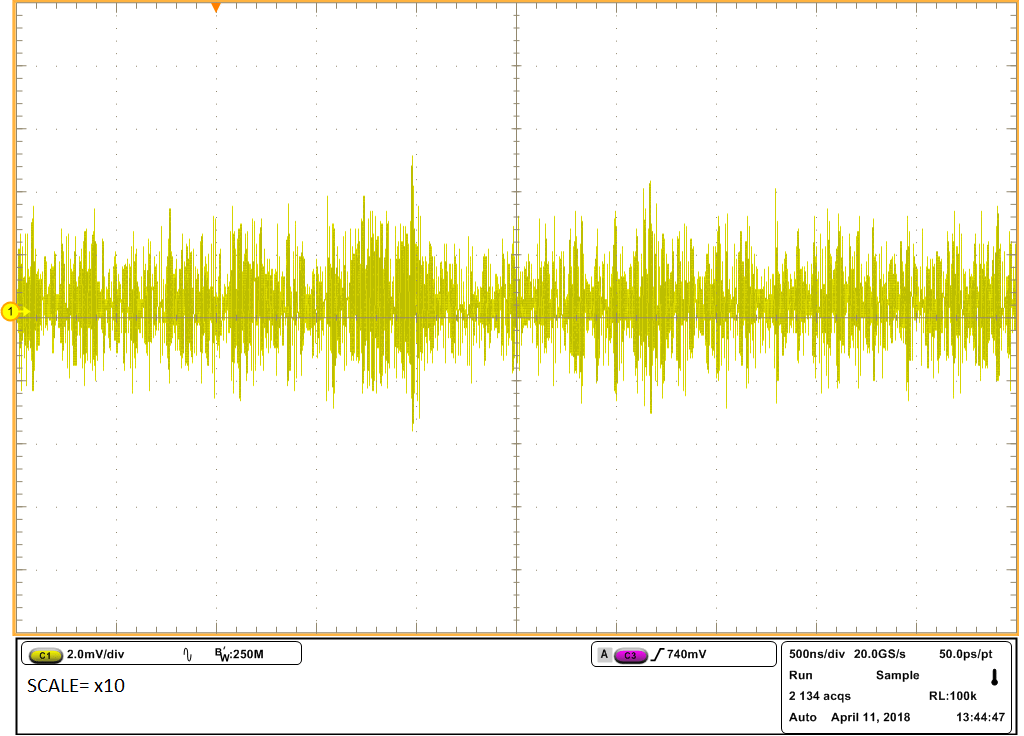Noise is divided into two categories: intrinsic and extrinsic. Intrinsic noise is unavoidable, every electronic device makes intrinsic noise. A LDO is supplied from ideal source, this means it is not affected by external influences, therefore there is no external noise at the input (though a LDO does have intrinsic noise at the output). Extrinsic noise is every noise which is generated by external influences (ripple at the input – real source). Ripple at the input is related to PSRR (Power Supply Rejection Ratio).
There are also different kinds of noise such as thermal and flicker. Thermal noise is caused by random thermal movement of particles, this movement is called diffusion. Thermal noise exists without connected external voltage. Unlike thermal, flicker noise is caused by random changes in the current of particles, this movement is call drift. Drift is caused by external voltage, which means that flicker noise cannot exist without external voltage.
Noise can also be divided by frequency spectrum. We identify specific noise frequency spectrums by color. For example white, pink, brown, grey etc. The first noise to be identified by color was white noise, which has flat frequency spectrum in whole range.
So how do we measure noise? As mentioned, intrinsic noise is noise generated by LDO with ideal source at the input. In real measurement this ideal source could be, for example, a battery, which has much lower intrinsic noise than LDO regulators. This noise is dependent on frequency and it is expressed by a parameter such as the Spectral Noise Density curve or Integral noise value (output noise voltage over specific frequency range, usually 10 Hz – 100 kHz expressed in microvolts – uVRMS).
 But what is Spectral Noise Density? If you measure noise in time you can see only absolute amplitude value of noise, but you cannot see frequency of all noise attributes. As in the picture above, noise is in scale x10. The Spectral Noise Density curve is the sum of noise contributes. Each contribute is measured in tight frequency range. You can see Spectral Noise Density on following pictures.
But what is Spectral Noise Density? If you measure noise in time you can see only absolute amplitude value of noise, but you cannot see frequency of all noise attributes. As in the picture above, noise is in scale x10. The Spectral Noise Density curve is the sum of noise contributes. Each contribute is measured in tight frequency range. You can see Spectral Noise Density on following pictures.
 Noise at the output of LDO is also dependent on load. Load consumes current IOUT and that value of current equals to resistance RLOAD. Dependence on load is multiple of RLOAD and output capacitor COUT. Higher value of RLOAD or higher value of COUT means moving of curve part which is depended on load to lower frequency. On the picture above you can see dependence on IOUT and on the following picture you can see dependence on COUT.
Noise at the output of LDO is also dependent on load. Load consumes current IOUT and that value of current equals to resistance RLOAD. Dependence on load is multiple of RLOAD and output capacitor COUT. Higher value of RLOAD or higher value of COUT means moving of curve part which is depended on load to lower frequency. On the picture above you can see dependence on IOUT and on the following picture you can see dependence on COUT.

ON Semiconductor has a broad portfolio of LDOs with various noise parameters. Standard LDOs usually have integral noise typically above 50 uVRMS, there are low noise products (noise < 30 uVRMS ) and ultra-low noise parts (noise < 15 uVRMS). An example of the latest ultra-low noise LDOs is NCP160 / NCP161 / NCP163 / NCP167 family and NCP110. These LDOs have integral noise below 10 uVRMS, which is ideal for sensitive applications like RF, sensors, cameras, smartphones, tablets or Wireless LAN.
But how does one express how much noise the output of LDO makes? It can be expressed in the Integral Noise Frequency Range as shown above. This range is usually 10 Hz – 100 kHz. Stay tuned for part two in which we will address this next question more in depth.










